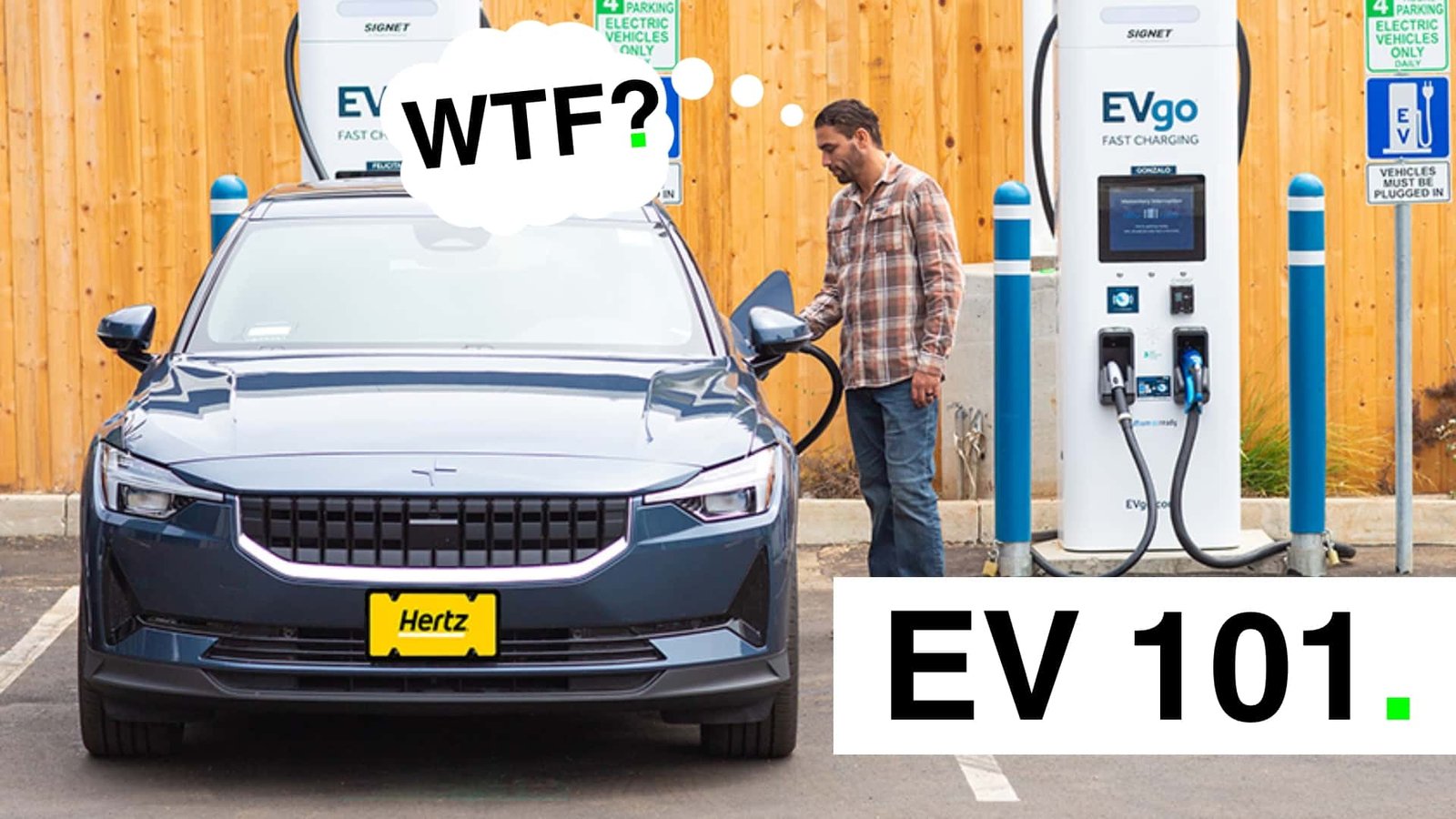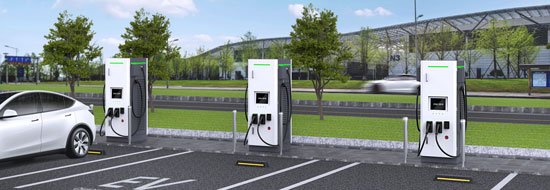First time renting an EV? Don’t panic. Just read this handy guide to charging, range and more.


Feb 26, 2024 at 2:11pm ET
So, you’ve just been handed the keys—or in Tesla’s case, the key card—to an electric rental car. No, you didn’t ask for one. No, you’ve never driven one before. It’s just what Hertz or Avis or Budget had on hand.
You’re experiencing something that has happened to a lot of people over the past few years: renting an EV with no heads up first, no preparation and maybe no real-world experience on how to operate such a car. But we’re here to help.
The first step here is not to panic. (Also, a little-known fact: After a recent software update, the Tesla Model 3 can now smell fear.) Step two is to reference this handy guide we’ve put together for first-time EV renters. It’ll tell you, in basic terms, what to know, where to charge and how to avoid a bad time.
Electric cars can take some getting used to at first, but they’re fairly simple to live with once you get the hang of things, learn where your chargers are and learn how to plan ahead a bit. We’ll walk you through all of that here.
Determining Your State of Charge
The biggest thing to know is that you’ll need to think a bit harder about refueling than you’re used to. Gas stations are abundant enough that you can generally wait until you’re basically on “E” to start looking for one. EV charging requires some more planning ahead.
That starts and ends with keeping an eye on your “state of charge” (SOC) and range. Somewhere on one of your car’s screens, you’ll see a readout indicating your vehicle’s battery level and how many miles of driving that should get you.
EVs in rental fleets should have a total range of 250-300 miles, give or take. But they won’t always be fully charged when you drive off the lot, so this is important to check as you head out.
Check the dashboard or the central infotainment screen to find your charge level, often in miles (or kilometers) to go and/or a total percentage. On a Tesla, that number will be pretty prominently displayed with a little battery icon, like your smartphone. On a Polestar 2, it’ll be on the dashboard screen above the steering wheel. That range level will determine if you can head to your destination, or if you need to stop and charge first.
EV Range, Explained
The range quoted by your EV is just an estimate and should be taken with a grain of salt. So if your destination is, let’s say, 100 miles away, 105 miles of range probably isn’t going to cut it. This is important to know for planning charging stops.
Driving at highway speeds and running the heater will sap your range more quickly than trundling around town when it’s a balmy 72 degrees out, for example. Hills can also do some damage. So it’s safest to maintain a healthy range buffer. If you have 200 miles of range remaining, plan to stop in 150 or so.
Building some wiggle room into your travels is also a good idea because there are plenty of places in the U.S. where, unfortunately, the nearest charging station isn’t all that closeby.
Note: Teslas are, in general, a bit more convenient to drive than other EVs. If you input a destination into a Tesla’s built-in navigation system, the car will suggest necessary stops at Supercharger locations along your route. That takes a lot of the guesswork out of things.
Where To Charge An Electric Car
Charging is probably the most daunting part of EV life for newcomers. We’re going to start with the basics first and then get more advanced.
First of all, Google Maps is fairly good at locating EV chargers. But many EV drivers swear by another app called PlugShare. Download it immediately—it will be your new best friend. Thank us later.
There are two types of public chargers: Level 2 and Level 3. In layman’s terms, these can be described as “slow” and “fast,” respectively. Level 3 plugs are also sometimes referred to as DC chargers (as in direct current). Level 2 chargers will fuel you up overnight, or over a course of hours; Level 3 chargers will do it in a matter of minutes.
Level 2 plugs are often found at hotels and inside parking garages. They charge vehicles rather slowly, so they’re most useful if you plan on leaving your car for hours at a time. They’ll be labeled with a power rating of anywhere between 3 and 20 kilowatts (kW) or so and take several hours to charge a vehicle most of the way.
Level 3 plugs are offered by Tesla’s Supercharger network and other providers like EVgo, ChargePoint and Electrify America. They’ll recharge most of an EV’s battery in anywhere from 20-45 minutes, depending on the vehicle and the particular charging station. These types of chargers are what you need if you want to charge up and be on your way quickly, such as during a road trip.
They’re rated to output anywhere from 50 to 350 kW. If this means nothing to you, don’t worry. More on that later.
How To Find EV Chargers
On PlugShare, you can filter by charger type, like Tesla or CCS—that’s the type of plug that non-Tesla cars use. You can also filter by the power level and other parameters, and see recent reviews from other drivers who recently checked in. Since it isn’t uncommon for EV chargers to be out of order, it’s good to get in the habit of checking PlugShare so other folks can tell you if the station you want to use is good or not.
Here’s an example: If you’re driving a Chevy and looking for a fast fill-up, you may want to filter out locations that are rated for less than 50 kW or only have Tesla plugs.
There’s some nuance here, but to keep things simple: Tesla Superchargers use a Tesla-specific charging plug and are thus only available to Tesla’s cars. So if you’ve rented a Chevrolet Bolt, Kia EV6, Polestar 2 or the like, look for non-Tesla charging stations. These will offer the CCS plug for Level 3 charging and/or a J1772 plug for Level 2 charging.
On the flip side, if you’re renting a Tesla, focus on Supercharger locations for fast charging. That’s Tesla’s proprietary network of EV chargers. There are tons of them. In addition to the methods described above, you can locate Superchargers using the Tesla app or your Tesla’s touchscreen. Tesla Destination locations provide slow charging.
How To Charge Your Electric Car: The Basics
You’ve located a station and pulled in. Terrific. Now, consult the owner’s manual or Google around to figure out how to open the charging port. Many EVs have these in different locations. Some open with a button or a feature on the touchscreen, others open up manually.
Now, push the charger into your car’s port until it clicks into place, and then swipe or tap a credit card at the attached kiosk. Some stations may require you to download their app and activate/pay for charging that way.
To avoid a bad time, anticipate charging errors and plan accordingly. Note that EV chargers are often finicky and may spit out errors a couple of times before successfully accepting your payment. Some will refuse to cooperate entirely, forcing you to try an adjacent stall or another station altogether.
If you’re sensing a pattern that Teslas work a bit differently from other EVs, you’re correct. At Superchargers, there’s no swiping or tapping on a touchscreen required. You simply pull up, plug in and the billing takes care of itself through the account attached to the vehicle. Your charging costs will be added to your final bill.
Advanced Charging Tips
Fundamentally, charging an electric car comes down to locating a station that suits your needs (slow or fast) and your car (Tesla or not). Some bonus tips will make your experience even better.
A charging plug with a higher power rating, expressed in kW, can provide a quicker charge. But only if your vehicle can handle the extra power. The higher the kW, the faster the charge, if your rental car is up for it.
For example, a Polestar 2 can handle up to 205 kW or 155 kW, depending on configuration. That means the max charging speed the car can accept is up to 205 kW or 155 kW, although odds are it won’t be at that speed all of the time.
A Kia EV6—rated to accept some 230 kW—can charge from 10-80% in a blistering (for EVs) 18 minutes on a sufficiently powerful plug. In that car, it may be worth seeking out higher-powered stations to maximize charging speeds.
A Chevrolet Bolt, on the other hand, maxes out at 55 kW. So whether you find a station rated for 100, 150 or 350 kilowatts, the resulting charging time won’t change.
Another important thing to know: Charging speeds slow down greatly once an EV’s battery reaches 80% capacity or so. That’s just how batteries work. So, once you hit 80%, consider hitting the road. It’ll save you time in the long run. It’s better for overall battery health, which isn’t your problem in a rental car, but it does free up a charging stall for someone else to use.
When You Should Push Back
EVs are fun and relatively simple to live with in most situations. But if you plan to adventure far off the beaten path, you may want to demand a gas-powered car. We’re talking about camping deep in the desert, long road trips through rural areas and the like.
Charging stations are becoming more abundant, but you still need to plan deliberately and only venture to places where you can charge at a public station or at a residence.
What To Do If You Get Stranded
Realistically, this isn’t a big risk if you keep an eye on your range. But emergencies happen. People run out of gas every now and then.
Most likely, this scenario will require getting towed to the nearest charging station or back to the rental agency. AAA also offers mobile charging in some areas. The service can send out a portable charger that can provide just enough juice to get you on your way.
What To Do At The End
This is just like a gas car: you’re not supposed to return it with an empty tank, and in fact you can incur penalties for that.
To avoid fees, you’ll have to top your battery up to the level it was at when you received the car. (Or, in Avis’ case, 70%.) So remember to build some extra travel time into your final trip to the airport or rental agency.
Remember, even as the EV charging network grows, it’s all about planning ahead. Know where you’re going, where you can charge, how far you’ll be driving and what obstacles might get in your way. With a little bit of planning, you may go from EV rental panic to going electric the next time you buy a car.
Contact the author: tim.levin@insideevs.com
[ad_2]
Source link




